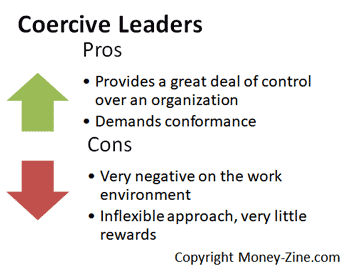The coercive leader was first described by Daniel Goleman in conjunction with the six leadership styles defined in his theory of Emotional Intelligence. While managers understand the need to adapt different styles to changing conditions, the coercive style is one that should be used with caution.
Attributes of Coercive Leaders
Goleman uses the following phrase to summarize the style of coercive leaders: "Do as I say." The style is most effective when an organization or group is faced with a crisis. This can range from dealing with ineffective employees to a complete turnaround for a company or group.
| Additional Resources |
| Coaching Leadership Democratic LeadershipPacesetting Leadership Trait Theory of Leadership |
For example, if a department is having trouble with employees using unsafe work practices, the leader might utilize the coercive style to gain immediate compliance with the company's safety standards. A manager might also employ this style when a business unit is not operating profitably due to wasteful practices.
Pros and Cons
One of the advantages of using the coercive style is the leader has a great deal of control over what's happening in their particular organization. He or she is providing direction and demanding conformance. This works especially well when an organization is in trouble. On the other hand, research has found this style has a very negative impact on the overall work climate. In fact, by its very nature the coercive style is inflexible, provides little reward, and removes from workers all responsibilities for their actions; just as long as they are following orders.

While some workers actually enjoy being told exactly what to do each day, the majority will find the coercive style unbearable over the long haul.
Effectively Using the Coercive Style
The two most important factors to keep in mind when using this style are as follows:
It's most effective when a turnaround is essential to a department's viability, or there exists a business need for immediate compliance with an instruction or order.
This style has the most negative impact on workers, so it should only be used for a short period of time. Once the crisis has subsided, the leader should begin practicing a more positive approach such as the affiliative style.
Managers that find themselves in a situation that no longer demands the use of this style should also consider taking steps to undo the damage it may have caused their department. For example, the manager might want to reward the employees or followers after the crisis is over. Another approach would be to hold a teambuilding session to help regain a feeling of teamwork and cooperation among the members.
Examples of the Coercive Style
It's easy to recognize a situation where someone is using the coercive leadership style at work. Words that might be used to describe this kind of individual include: relentless, overbearing, unyielding, persistent, harsh, and ruthless. The words that are synonymous with coercion usually leave people with a very negative feeling inside. That's how workers feel when they report to a manager that doesn't realize it's time to stop using the coercive style. This brings up a final point that's important to understand. There is a time and a place where the coercive style is extremely effective; especially during a crisis. The troubling part about this style is when it's abused. Managers that act as if there is a crisis everyday, and continue to use this style over a long period of time, do more harm than good to an organization's morale. Left unchecked, it can also result in degradation in employee performance too.
About the Author - Coercive Leadership


